Analyzing Brand Loyalty, Consumer Satisfaction in Retail Industry
VerifiedAdded on 2023/04/23
|77
|24441
|293
Project
AI Summary
This research project investigates the intricate relationship between brand loyalty, consumer satisfaction, and purchase decisions within the retail industry, specifically focusing on the Saudi Arabian market. The study delves into the impact of brand loyalty on consumer behavior, exploring how a customer's preference for a particular brand influences their purchasing choices. It also examines the role of customer satisfaction, analyzing how meeting consumer expectations in terms of product quality, price, and overall experience affects their willingness to make a purchase. The project further explores the influence of retail brand performance, brand efficiency, and consumer intentions. The research employs both quantitative and qualitative data analysis to provide a comprehensive understanding of these factors and their interplay in shaping consumer behavior within the retail sector. The findings aim to provide insights into how businesses can foster brand loyalty and enhance customer satisfaction to drive purchase decisions and achieve commercial success.
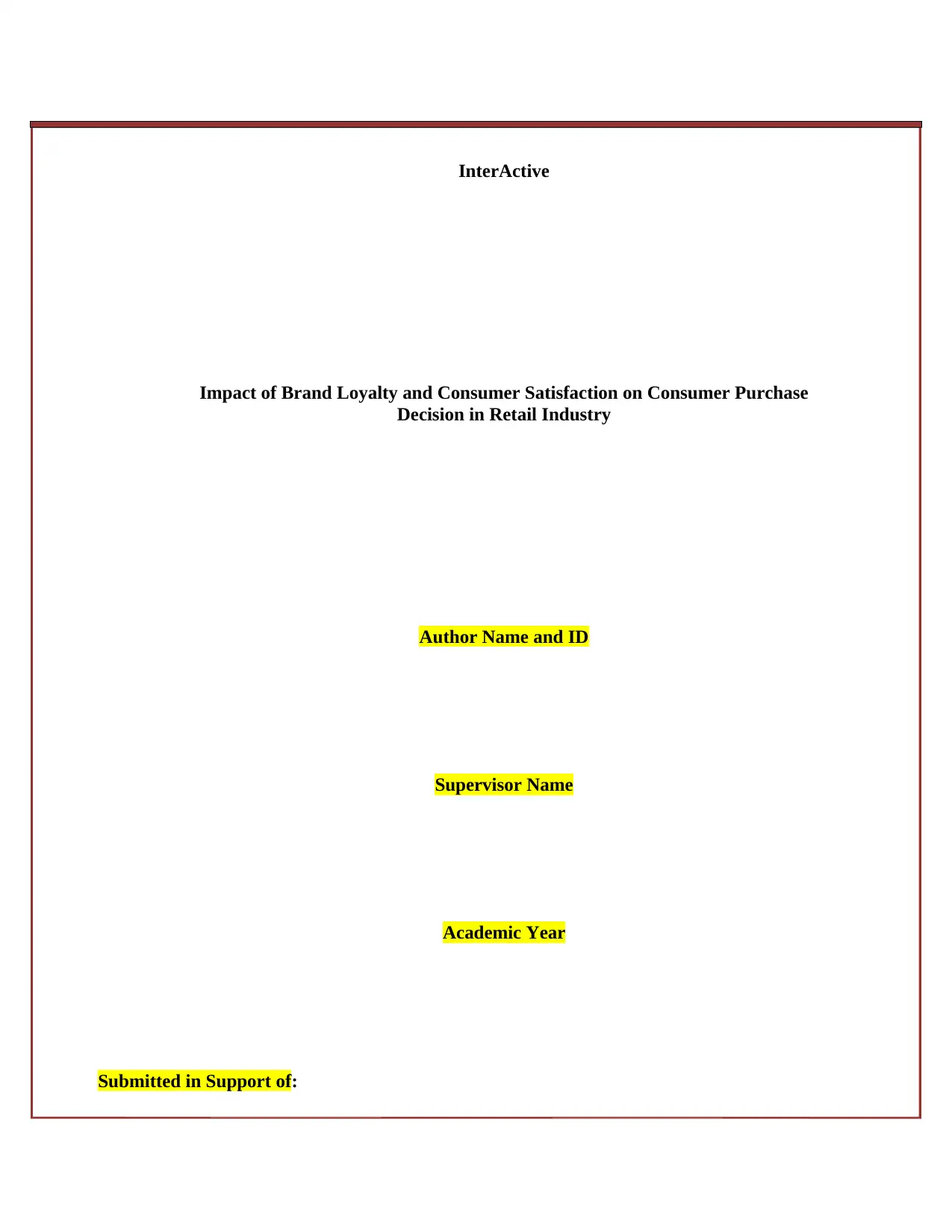
InterActive
Impact of Brand Loyalty and Consumer Satisfaction on Consumer Purchase
Decision in Retail Industry
Author Name and ID
Supervisor Name
Academic Year
Submitted in Support of:
Impact of Brand Loyalty and Consumer Satisfaction on Consumer Purchase
Decision in Retail Industry
Author Name and ID
Supervisor Name
Academic Year
Submitted in Support of:
Paraphrase This Document
Need a fresh take? Get an instant paraphrase of this document with our AI Paraphraser
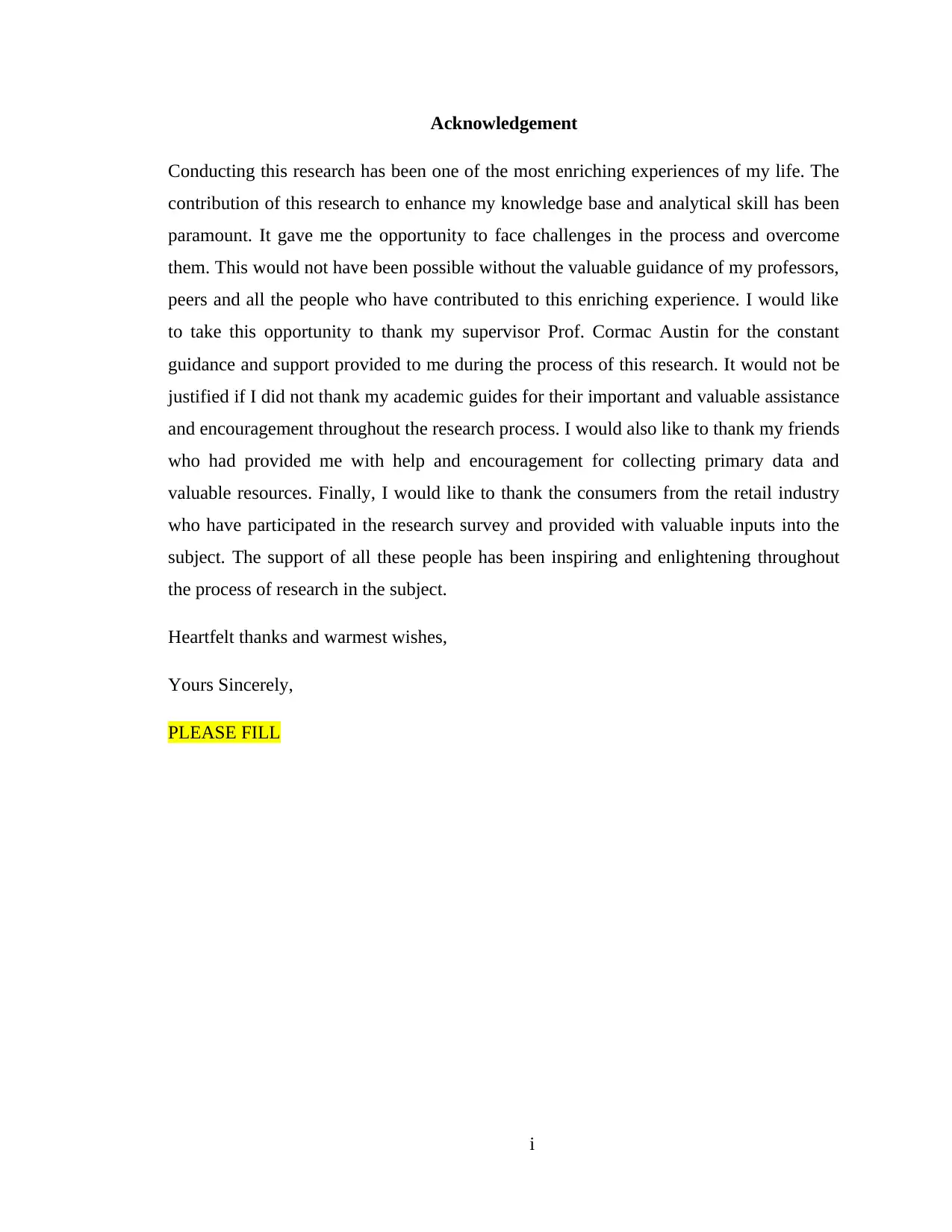
Acknowledgement
Conducting this research has been one of the most enriching experiences of my life. The
contribution of this research to enhance my knowledge base and analytical skill has been
paramount. It gave me the opportunity to face challenges in the process and overcome
them. This would not have been possible without the valuable guidance of my professors,
peers and all the people who have contributed to this enriching experience. I would like
to take this opportunity to thank my supervisor Prof. Cormac Austin for the constant
guidance and support provided to me during the process of this research. It would not be
justified if I did not thank my academic guides for their important and valuable assistance
and encouragement throughout the research process. I would also like to thank my friends
who had provided me with help and encouragement for collecting primary data and
valuable resources. Finally, I would like to thank the consumers from the retail industry
who have participated in the research survey and provided with valuable inputs into the
subject. The support of all these people has been inspiring and enlightening throughout
the process of research in the subject.
Heartfelt thanks and warmest wishes,
Yours Sincerely,
PLEASE FILL
i
Conducting this research has been one of the most enriching experiences of my life. The
contribution of this research to enhance my knowledge base and analytical skill has been
paramount. It gave me the opportunity to face challenges in the process and overcome
them. This would not have been possible without the valuable guidance of my professors,
peers and all the people who have contributed to this enriching experience. I would like
to take this opportunity to thank my supervisor Prof. Cormac Austin for the constant
guidance and support provided to me during the process of this research. It would not be
justified if I did not thank my academic guides for their important and valuable assistance
and encouragement throughout the research process. I would also like to thank my friends
who had provided me with help and encouragement for collecting primary data and
valuable resources. Finally, I would like to thank the consumers from the retail industry
who have participated in the research survey and provided with valuable inputs into the
subject. The support of all these people has been inspiring and enlightening throughout
the process of research in the subject.
Heartfelt thanks and warmest wishes,
Yours Sincerely,
PLEASE FILL
i
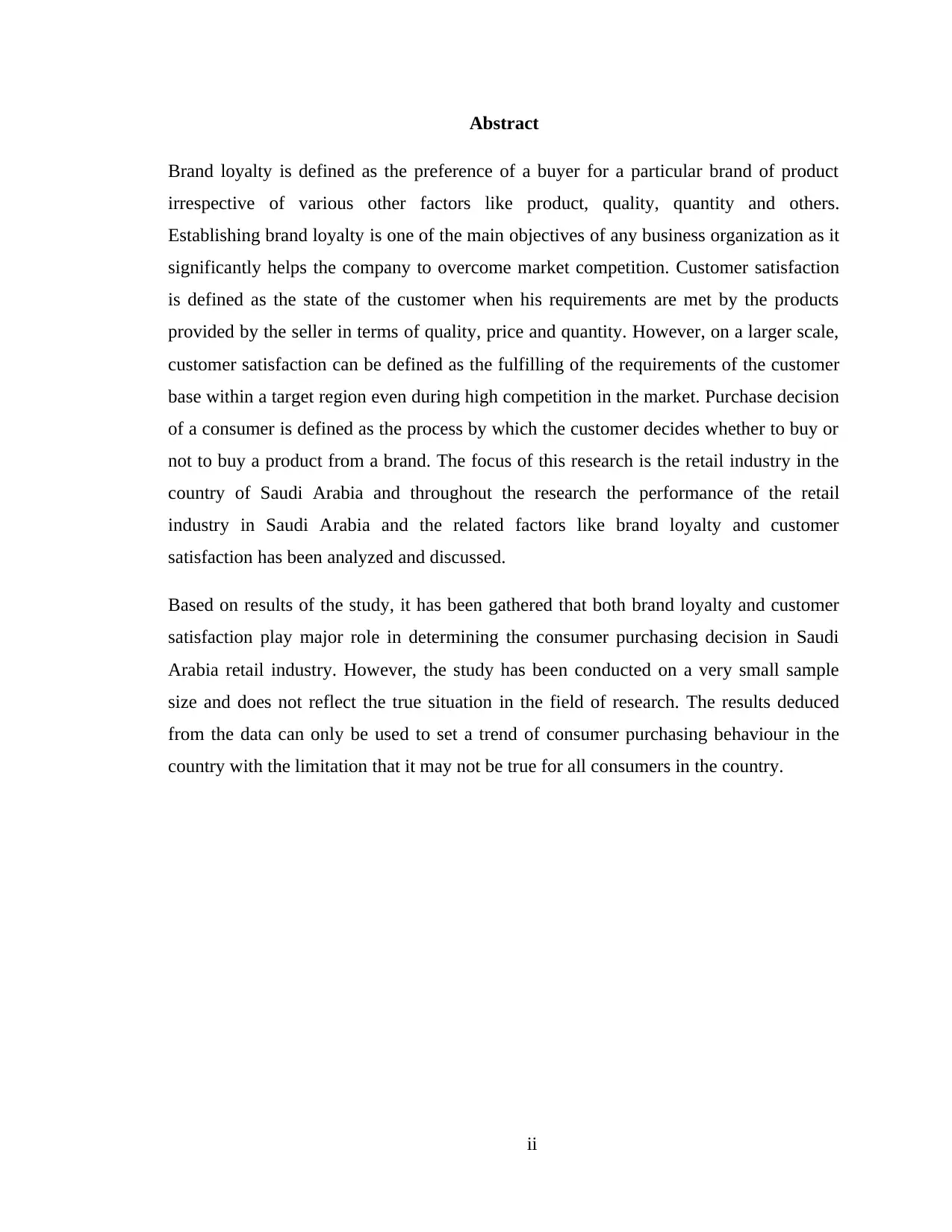
Abstract
Brand loyalty is defined as the preference of a buyer for a particular brand of product
irrespective of various other factors like product, quality, quantity and others.
Establishing brand loyalty is one of the main objectives of any business organization as it
significantly helps the company to overcome market competition. Customer satisfaction
is defined as the state of the customer when his requirements are met by the products
provided by the seller in terms of quality, price and quantity. However, on a larger scale,
customer satisfaction can be defined as the fulfilling of the requirements of the customer
base within a target region even during high competition in the market. Purchase decision
of a consumer is defined as the process by which the customer decides whether to buy or
not to buy a product from a brand. The focus of this research is the retail industry in the
country of Saudi Arabia and throughout the research the performance of the retail
industry in Saudi Arabia and the related factors like brand loyalty and customer
satisfaction has been analyzed and discussed.
Based on results of the study, it has been gathered that both brand loyalty and customer
satisfaction play major role in determining the consumer purchasing decision in Saudi
Arabia retail industry. However, the study has been conducted on a very small sample
size and does not reflect the true situation in the field of research. The results deduced
from the data can only be used to set a trend of consumer purchasing behaviour in the
country with the limitation that it may not be true for all consumers in the country.
ii
Brand loyalty is defined as the preference of a buyer for a particular brand of product
irrespective of various other factors like product, quality, quantity and others.
Establishing brand loyalty is one of the main objectives of any business organization as it
significantly helps the company to overcome market competition. Customer satisfaction
is defined as the state of the customer when his requirements are met by the products
provided by the seller in terms of quality, price and quantity. However, on a larger scale,
customer satisfaction can be defined as the fulfilling of the requirements of the customer
base within a target region even during high competition in the market. Purchase decision
of a consumer is defined as the process by which the customer decides whether to buy or
not to buy a product from a brand. The focus of this research is the retail industry in the
country of Saudi Arabia and throughout the research the performance of the retail
industry in Saudi Arabia and the related factors like brand loyalty and customer
satisfaction has been analyzed and discussed.
Based on results of the study, it has been gathered that both brand loyalty and customer
satisfaction play major role in determining the consumer purchasing decision in Saudi
Arabia retail industry. However, the study has been conducted on a very small sample
size and does not reflect the true situation in the field of research. The results deduced
from the data can only be used to set a trend of consumer purchasing behaviour in the
country with the limitation that it may not be true for all consumers in the country.
ii
⊘ This is a preview!⊘
Do you want full access?
Subscribe today to unlock all pages.

Trusted by 1+ million students worldwide
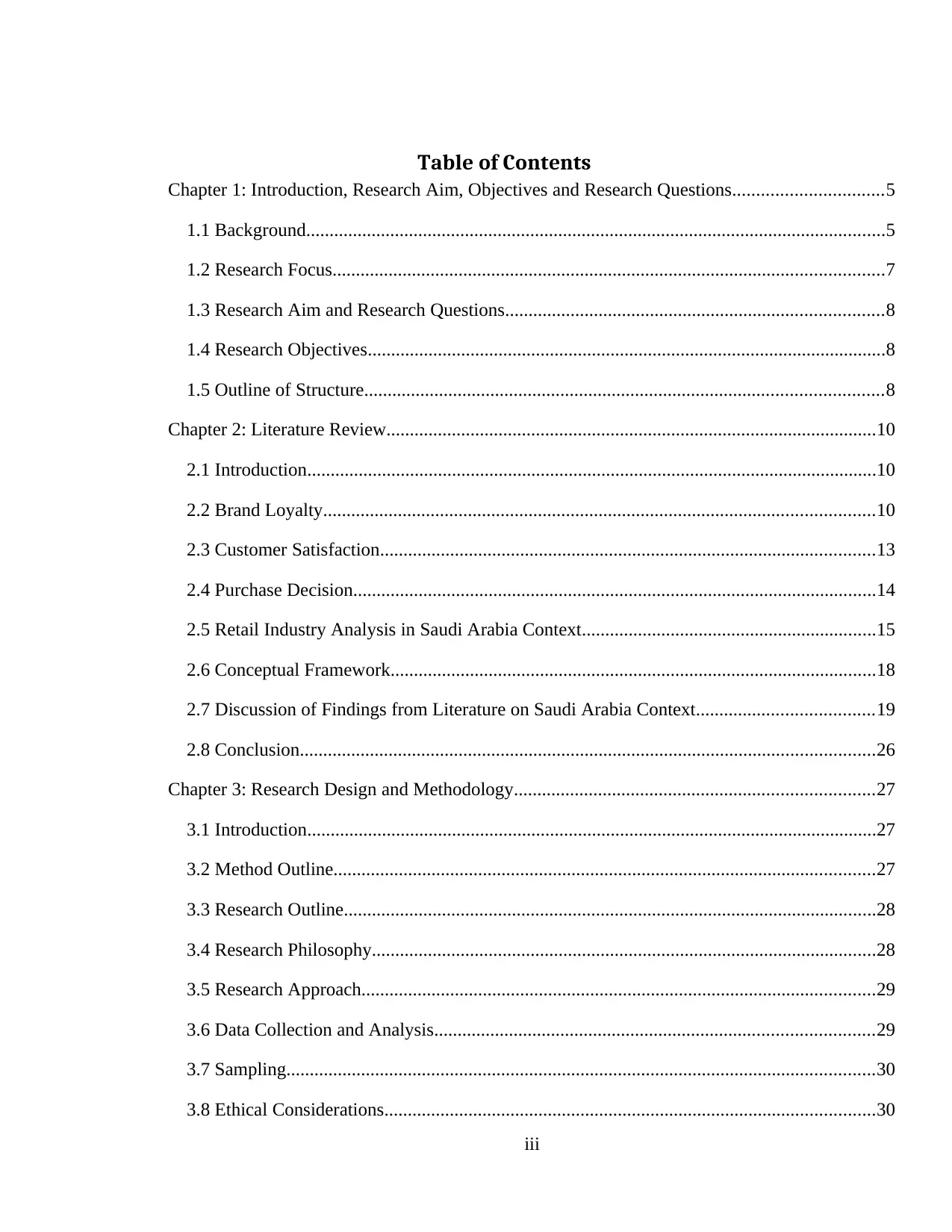
Table of Contents
Chapter 1: Introduction, Research Aim, Objectives and Research Questions................................5
1.1 Background............................................................................................................................5
1.2 Research Focus......................................................................................................................7
1.3 Research Aim and Research Questions.................................................................................8
1.4 Research Objectives...............................................................................................................8
1.5 Outline of Structure...............................................................................................................8
Chapter 2: Literature Review.........................................................................................................10
2.1 Introduction..........................................................................................................................10
2.2 Brand Loyalty......................................................................................................................10
2.3 Customer Satisfaction..........................................................................................................13
2.4 Purchase Decision................................................................................................................14
2.5 Retail Industry Analysis in Saudi Arabia Context...............................................................15
2.6 Conceptual Framework........................................................................................................18
2.7 Discussion of Findings from Literature on Saudi Arabia Context......................................19
2.8 Conclusion...........................................................................................................................26
Chapter 3: Research Design and Methodology.............................................................................27
3.1 Introduction..........................................................................................................................27
3.2 Method Outline....................................................................................................................27
3.3 Research Outline..................................................................................................................28
3.4 Research Philosophy............................................................................................................28
3.5 Research Approach..............................................................................................................29
3.6 Data Collection and Analysis..............................................................................................29
3.7 Sampling..............................................................................................................................30
3.8 Ethical Considerations.........................................................................................................30
iii
Chapter 1: Introduction, Research Aim, Objectives and Research Questions................................5
1.1 Background............................................................................................................................5
1.2 Research Focus......................................................................................................................7
1.3 Research Aim and Research Questions.................................................................................8
1.4 Research Objectives...............................................................................................................8
1.5 Outline of Structure...............................................................................................................8
Chapter 2: Literature Review.........................................................................................................10
2.1 Introduction..........................................................................................................................10
2.2 Brand Loyalty......................................................................................................................10
2.3 Customer Satisfaction..........................................................................................................13
2.4 Purchase Decision................................................................................................................14
2.5 Retail Industry Analysis in Saudi Arabia Context...............................................................15
2.6 Conceptual Framework........................................................................................................18
2.7 Discussion of Findings from Literature on Saudi Arabia Context......................................19
2.8 Conclusion...........................................................................................................................26
Chapter 3: Research Design and Methodology.............................................................................27
3.1 Introduction..........................................................................................................................27
3.2 Method Outline....................................................................................................................27
3.3 Research Outline..................................................................................................................28
3.4 Research Philosophy............................................................................................................28
3.5 Research Approach..............................................................................................................29
3.6 Data Collection and Analysis..............................................................................................29
3.7 Sampling..............................................................................................................................30
3.8 Ethical Considerations.........................................................................................................30
iii
Paraphrase This Document
Need a fresh take? Get an instant paraphrase of this document with our AI Paraphraser
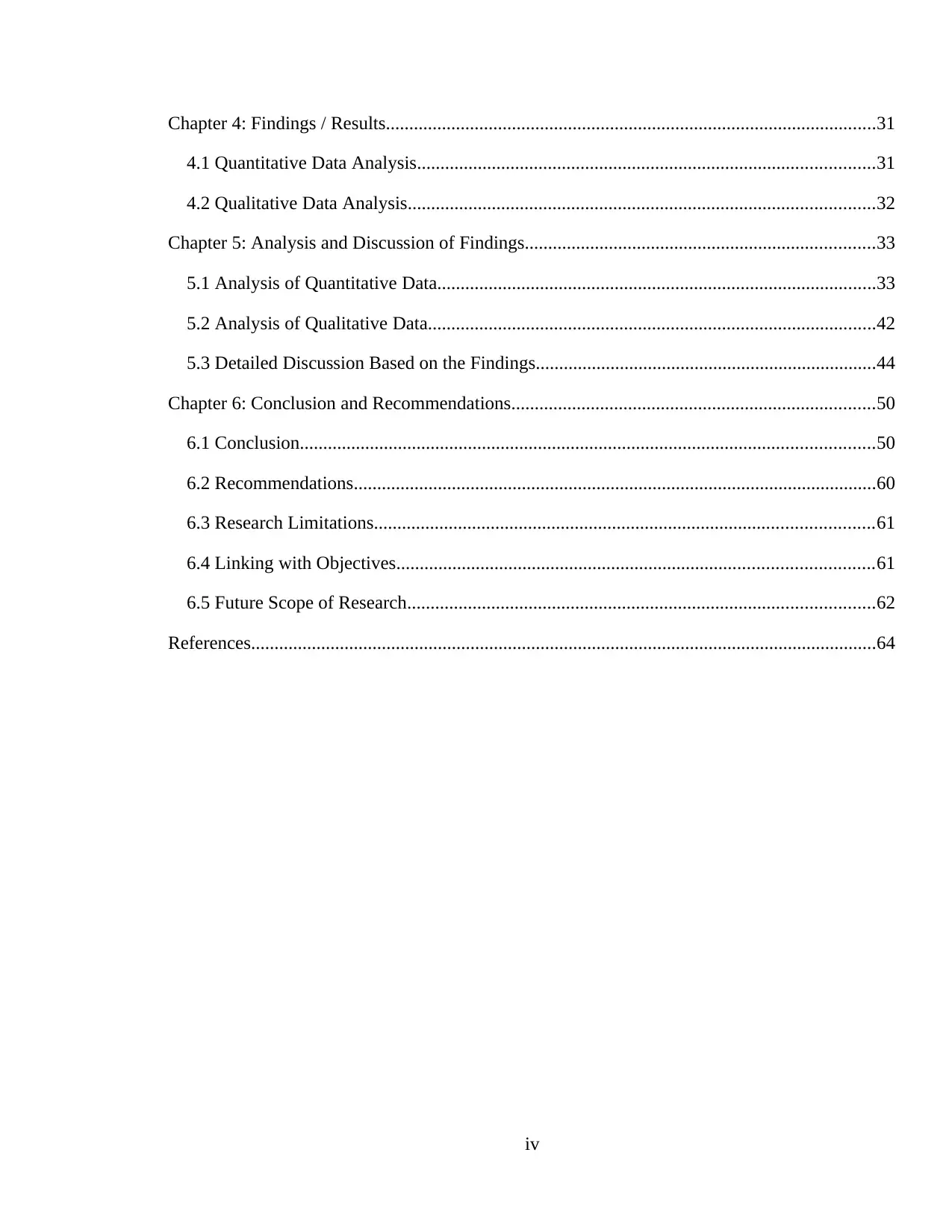
Chapter 4: Findings / Results.........................................................................................................31
4.1 Quantitative Data Analysis..................................................................................................31
4.2 Qualitative Data Analysis....................................................................................................32
Chapter 5: Analysis and Discussion of Findings...........................................................................33
5.1 Analysis of Quantitative Data..............................................................................................33
5.2 Analysis of Qualitative Data................................................................................................42
5.3 Detailed Discussion Based on the Findings.........................................................................44
Chapter 6: Conclusion and Recommendations..............................................................................50
6.1 Conclusion...........................................................................................................................50
6.2 Recommendations................................................................................................................60
6.3 Research Limitations...........................................................................................................61
6.4 Linking with Objectives......................................................................................................61
6.5 Future Scope of Research....................................................................................................62
References......................................................................................................................................64
iv
4.1 Quantitative Data Analysis..................................................................................................31
4.2 Qualitative Data Analysis....................................................................................................32
Chapter 5: Analysis and Discussion of Findings...........................................................................33
5.1 Analysis of Quantitative Data..............................................................................................33
5.2 Analysis of Qualitative Data................................................................................................42
5.3 Detailed Discussion Based on the Findings.........................................................................44
Chapter 6: Conclusion and Recommendations..............................................................................50
6.1 Conclusion...........................................................................................................................50
6.2 Recommendations................................................................................................................60
6.3 Research Limitations...........................................................................................................61
6.4 Linking with Objectives......................................................................................................61
6.5 Future Scope of Research....................................................................................................62
References......................................................................................................................................64
iv
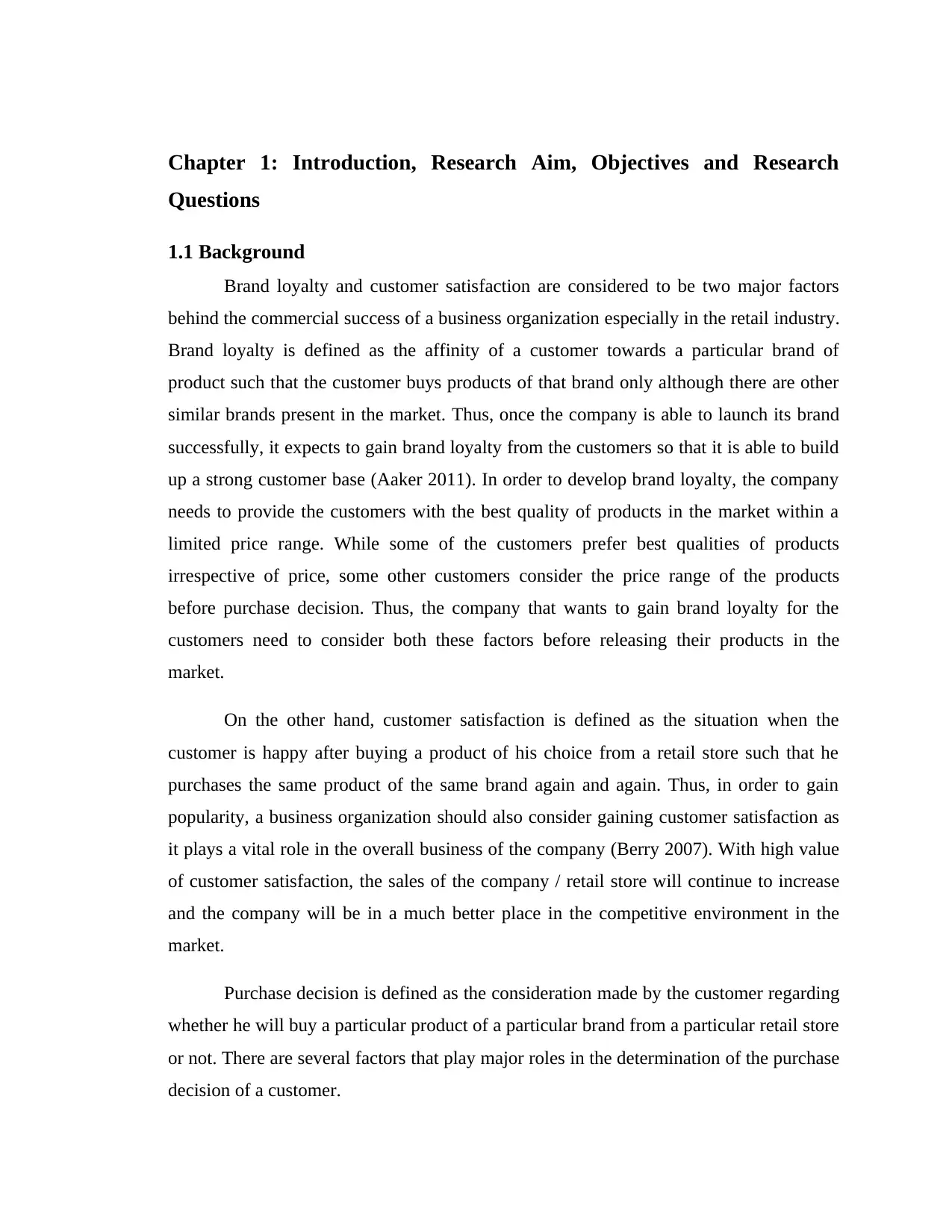
Chapter 1: Introduction, Research Aim, Objectives and Research
Questions
1.1 Background
Brand loyalty and customer satisfaction are considered to be two major factors
behind the commercial success of a business organization especially in the retail industry.
Brand loyalty is defined as the affinity of a customer towards a particular brand of
product such that the customer buys products of that brand only although there are other
similar brands present in the market. Thus, once the company is able to launch its brand
successfully, it expects to gain brand loyalty from the customers so that it is able to build
up a strong customer base (Aaker 2011). In order to develop brand loyalty, the company
needs to provide the customers with the best quality of products in the market within a
limited price range. While some of the customers prefer best qualities of products
irrespective of price, some other customers consider the price range of the products
before purchase decision. Thus, the company that wants to gain brand loyalty for the
customers need to consider both these factors before releasing their products in the
market.
On the other hand, customer satisfaction is defined as the situation when the
customer is happy after buying a product of his choice from a retail store such that he
purchases the same product of the same brand again and again. Thus, in order to gain
popularity, a business organization should also consider gaining customer satisfaction as
it plays a vital role in the overall business of the company (Berry 2007). With high value
of customer satisfaction, the sales of the company / retail store will continue to increase
and the company will be in a much better place in the competitive environment in the
market.
Purchase decision is defined as the consideration made by the customer regarding
whether he will buy a particular product of a particular brand from a particular retail store
or not. There are several factors that play major roles in the determination of the purchase
decision of a customer.
Questions
1.1 Background
Brand loyalty and customer satisfaction are considered to be two major factors
behind the commercial success of a business organization especially in the retail industry.
Brand loyalty is defined as the affinity of a customer towards a particular brand of
product such that the customer buys products of that brand only although there are other
similar brands present in the market. Thus, once the company is able to launch its brand
successfully, it expects to gain brand loyalty from the customers so that it is able to build
up a strong customer base (Aaker 2011). In order to develop brand loyalty, the company
needs to provide the customers with the best quality of products in the market within a
limited price range. While some of the customers prefer best qualities of products
irrespective of price, some other customers consider the price range of the products
before purchase decision. Thus, the company that wants to gain brand loyalty for the
customers need to consider both these factors before releasing their products in the
market.
On the other hand, customer satisfaction is defined as the situation when the
customer is happy after buying a product of his choice from a retail store such that he
purchases the same product of the same brand again and again. Thus, in order to gain
popularity, a business organization should also consider gaining customer satisfaction as
it plays a vital role in the overall business of the company (Berry 2007). With high value
of customer satisfaction, the sales of the company / retail store will continue to increase
and the company will be in a much better place in the competitive environment in the
market.
Purchase decision is defined as the consideration made by the customer regarding
whether he will buy a particular product of a particular brand from a particular retail store
or not. There are several factors that play major roles in the determination of the purchase
decision of a customer.
⊘ This is a preview!⊘
Do you want full access?
Subscribe today to unlock all pages.

Trusted by 1+ million students worldwide
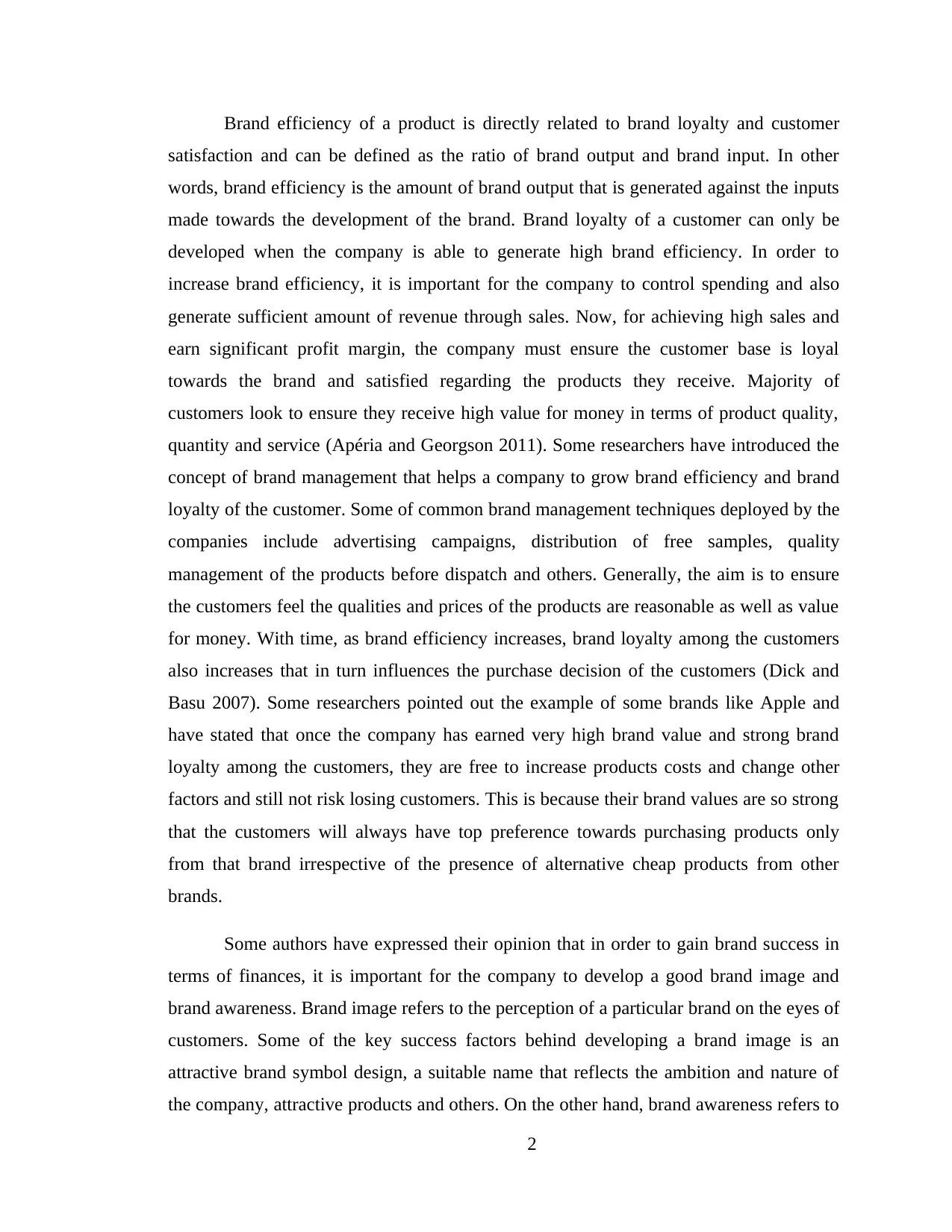
Brand efficiency of a product is directly related to brand loyalty and customer
satisfaction and can be defined as the ratio of brand output and brand input. In other
words, brand efficiency is the amount of brand output that is generated against the inputs
made towards the development of the brand. Brand loyalty of a customer can only be
developed when the company is able to generate high brand efficiency. In order to
increase brand efficiency, it is important for the company to control spending and also
generate sufficient amount of revenue through sales. Now, for achieving high sales and
earn significant profit margin, the company must ensure the customer base is loyal
towards the brand and satisfied regarding the products they receive. Majority of
customers look to ensure they receive high value for money in terms of product quality,
quantity and service (Apéria and Georgson 2011). Some researchers have introduced the
concept of brand management that helps a company to grow brand efficiency and brand
loyalty of the customer. Some of common brand management techniques deployed by the
companies include advertising campaigns, distribution of free samples, quality
management of the products before dispatch and others. Generally, the aim is to ensure
the customers feel the qualities and prices of the products are reasonable as well as value
for money. With time, as brand efficiency increases, brand loyalty among the customers
also increases that in turn influences the purchase decision of the customers (Dick and
Basu 2007). Some researchers pointed out the example of some brands like Apple and
have stated that once the company has earned very high brand value and strong brand
loyalty among the customers, they are free to increase products costs and change other
factors and still not risk losing customers. This is because their brand values are so strong
that the customers will always have top preference towards purchasing products only
from that brand irrespective of the presence of alternative cheap products from other
brands.
Some authors have expressed their opinion that in order to gain brand success in
terms of finances, it is important for the company to develop a good brand image and
brand awareness. Brand image refers to the perception of a particular brand on the eyes of
customers. Some of the key success factors behind developing a brand image is an
attractive brand symbol design, a suitable name that reflects the ambition and nature of
the company, attractive products and others. On the other hand, brand awareness refers to
2
satisfaction and can be defined as the ratio of brand output and brand input. In other
words, brand efficiency is the amount of brand output that is generated against the inputs
made towards the development of the brand. Brand loyalty of a customer can only be
developed when the company is able to generate high brand efficiency. In order to
increase brand efficiency, it is important for the company to control spending and also
generate sufficient amount of revenue through sales. Now, for achieving high sales and
earn significant profit margin, the company must ensure the customer base is loyal
towards the brand and satisfied regarding the products they receive. Majority of
customers look to ensure they receive high value for money in terms of product quality,
quantity and service (Apéria and Georgson 2011). Some researchers have introduced the
concept of brand management that helps a company to grow brand efficiency and brand
loyalty of the customer. Some of common brand management techniques deployed by the
companies include advertising campaigns, distribution of free samples, quality
management of the products before dispatch and others. Generally, the aim is to ensure
the customers feel the qualities and prices of the products are reasonable as well as value
for money. With time, as brand efficiency increases, brand loyalty among the customers
also increases that in turn influences the purchase decision of the customers (Dick and
Basu 2007). Some researchers pointed out the example of some brands like Apple and
have stated that once the company has earned very high brand value and strong brand
loyalty among the customers, they are free to increase products costs and change other
factors and still not risk losing customers. This is because their brand values are so strong
that the customers will always have top preference towards purchasing products only
from that brand irrespective of the presence of alternative cheap products from other
brands.
Some authors have expressed their opinion that in order to gain brand success in
terms of finances, it is important for the company to develop a good brand image and
brand awareness. Brand image refers to the perception of a particular brand on the eyes of
customers. Some of the key success factors behind developing a brand image is an
attractive brand symbol design, a suitable name that reflects the ambition and nature of
the company, attractive products and others. On the other hand, brand awareness refers to
2
Paraphrase This Document
Need a fresh take? Get an instant paraphrase of this document with our AI Paraphraser
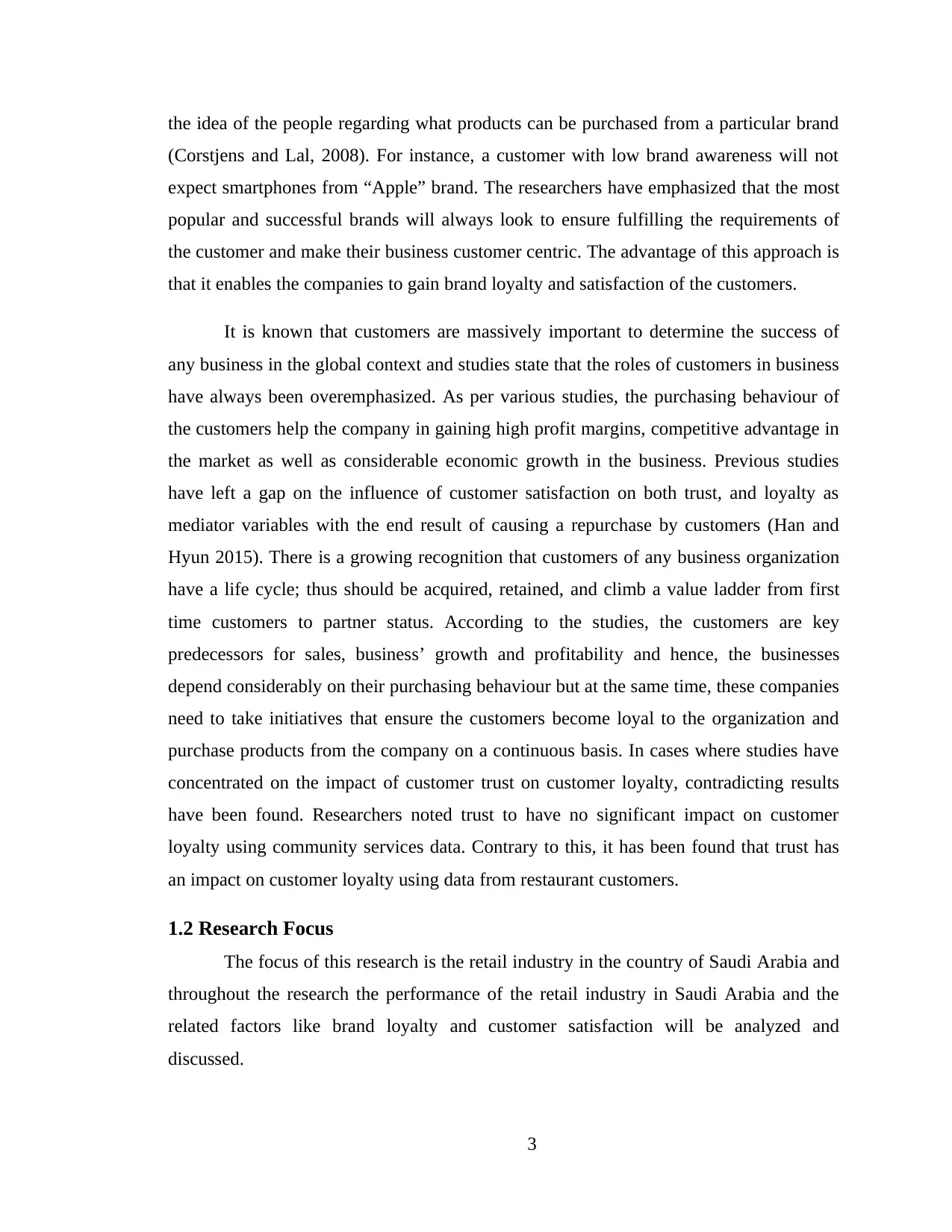
the idea of the people regarding what products can be purchased from a particular brand
(Corstjens and Lal, 2008). For instance, a customer with low brand awareness will not
expect smartphones from “Apple” brand. The researchers have emphasized that the most
popular and successful brands will always look to ensure fulfilling the requirements of
the customer and make their business customer centric. The advantage of this approach is
that it enables the companies to gain brand loyalty and satisfaction of the customers.
It is known that customers are massively important to determine the success of
any business in the global context and studies state that the roles of customers in business
have always been overemphasized. As per various studies, the purchasing behaviour of
the customers help the company in gaining high profit margins, competitive advantage in
the market as well as considerable economic growth in the business. Previous studies
have left a gap on the influence of customer satisfaction on both trust, and loyalty as
mediator variables with the end result of causing a repurchase by customers (Han and
Hyun 2015). There is a growing recognition that customers of any business organization
have a life cycle; thus should be acquired, retained, and climb a value ladder from first
time customers to partner status. According to the studies, the customers are key
predecessors for sales, business’ growth and profitability and hence, the businesses
depend considerably on their purchasing behaviour but at the same time, these companies
need to take initiatives that ensure the customers become loyal to the organization and
purchase products from the company on a continuous basis. In cases where studies have
concentrated on the impact of customer trust on customer loyalty, contradicting results
have been found. Researchers noted trust to have no significant impact on customer
loyalty using community services data. Contrary to this, it has been found that trust has
an impact on customer loyalty using data from restaurant customers.
1.2 Research Focus
The focus of this research is the retail industry in the country of Saudi Arabia and
throughout the research the performance of the retail industry in Saudi Arabia and the
related factors like brand loyalty and customer satisfaction will be analyzed and
discussed.
3
(Corstjens and Lal, 2008). For instance, a customer with low brand awareness will not
expect smartphones from “Apple” brand. The researchers have emphasized that the most
popular and successful brands will always look to ensure fulfilling the requirements of
the customer and make their business customer centric. The advantage of this approach is
that it enables the companies to gain brand loyalty and satisfaction of the customers.
It is known that customers are massively important to determine the success of
any business in the global context and studies state that the roles of customers in business
have always been overemphasized. As per various studies, the purchasing behaviour of
the customers help the company in gaining high profit margins, competitive advantage in
the market as well as considerable economic growth in the business. Previous studies
have left a gap on the influence of customer satisfaction on both trust, and loyalty as
mediator variables with the end result of causing a repurchase by customers (Han and
Hyun 2015). There is a growing recognition that customers of any business organization
have a life cycle; thus should be acquired, retained, and climb a value ladder from first
time customers to partner status. According to the studies, the customers are key
predecessors for sales, business’ growth and profitability and hence, the businesses
depend considerably on their purchasing behaviour but at the same time, these companies
need to take initiatives that ensure the customers become loyal to the organization and
purchase products from the company on a continuous basis. In cases where studies have
concentrated on the impact of customer trust on customer loyalty, contradicting results
have been found. Researchers noted trust to have no significant impact on customer
loyalty using community services data. Contrary to this, it has been found that trust has
an impact on customer loyalty using data from restaurant customers.
1.2 Research Focus
The focus of this research is the retail industry in the country of Saudi Arabia and
throughout the research the performance of the retail industry in Saudi Arabia and the
related factors like brand loyalty and customer satisfaction will be analyzed and
discussed.
3
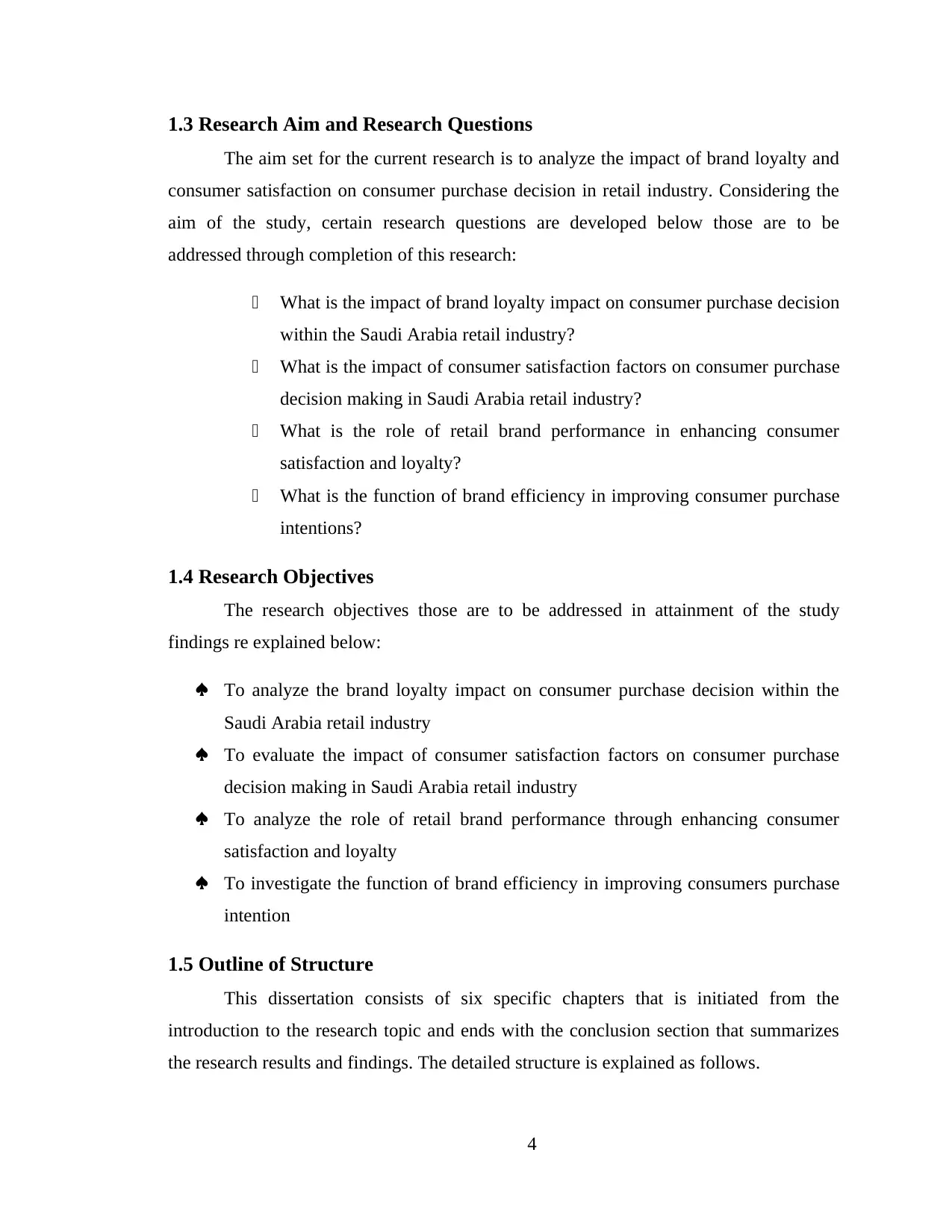
1.3 Research Aim and Research Questions
The aim set for the current research is to analyze the impact of brand loyalty and
consumer satisfaction on consumer purchase decision in retail industry. Considering the
aim of the study, certain research questions are developed below those are to be
addressed through completion of this research:
What is the impact of brand loyalty impact on consumer purchase decision
within the Saudi Arabia retail industry?
What is the impact of consumer satisfaction factors on consumer purchase
decision making in Saudi Arabia retail industry?
What is the role of retail brand performance in enhancing consumer
satisfaction and loyalty?
What is the function of brand efficiency in improving consumer purchase
intentions?
1.4 Research Objectives
The research objectives those are to be addressed in attainment of the study
findings re explained below:
To analyze the brand loyalty impact on consumer purchase decision within the
Saudi Arabia retail industry
To evaluate the impact of consumer satisfaction factors on consumer purchase
decision making in Saudi Arabia retail industry
To analyze the role of retail brand performance through enhancing consumer
satisfaction and loyalty
To investigate the function of brand efficiency in improving consumers purchase
intention
1.5 Outline of Structure
This dissertation consists of six specific chapters that is initiated from the
introduction to the research topic and ends with the conclusion section that summarizes
the research results and findings. The detailed structure is explained as follows.
4
The aim set for the current research is to analyze the impact of brand loyalty and
consumer satisfaction on consumer purchase decision in retail industry. Considering the
aim of the study, certain research questions are developed below those are to be
addressed through completion of this research:
What is the impact of brand loyalty impact on consumer purchase decision
within the Saudi Arabia retail industry?
What is the impact of consumer satisfaction factors on consumer purchase
decision making in Saudi Arabia retail industry?
What is the role of retail brand performance in enhancing consumer
satisfaction and loyalty?
What is the function of brand efficiency in improving consumer purchase
intentions?
1.4 Research Objectives
The research objectives those are to be addressed in attainment of the study
findings re explained below:
To analyze the brand loyalty impact on consumer purchase decision within the
Saudi Arabia retail industry
To evaluate the impact of consumer satisfaction factors on consumer purchase
decision making in Saudi Arabia retail industry
To analyze the role of retail brand performance through enhancing consumer
satisfaction and loyalty
To investigate the function of brand efficiency in improving consumers purchase
intention
1.5 Outline of Structure
This dissertation consists of six specific chapters that is initiated from the
introduction to the research topic and ends with the conclusion section that summarizes
the research results and findings. The detailed structure is explained as follows.
4
⊘ This is a preview!⊘
Do you want full access?
Subscribe today to unlock all pages.

Trusted by 1+ million students worldwide
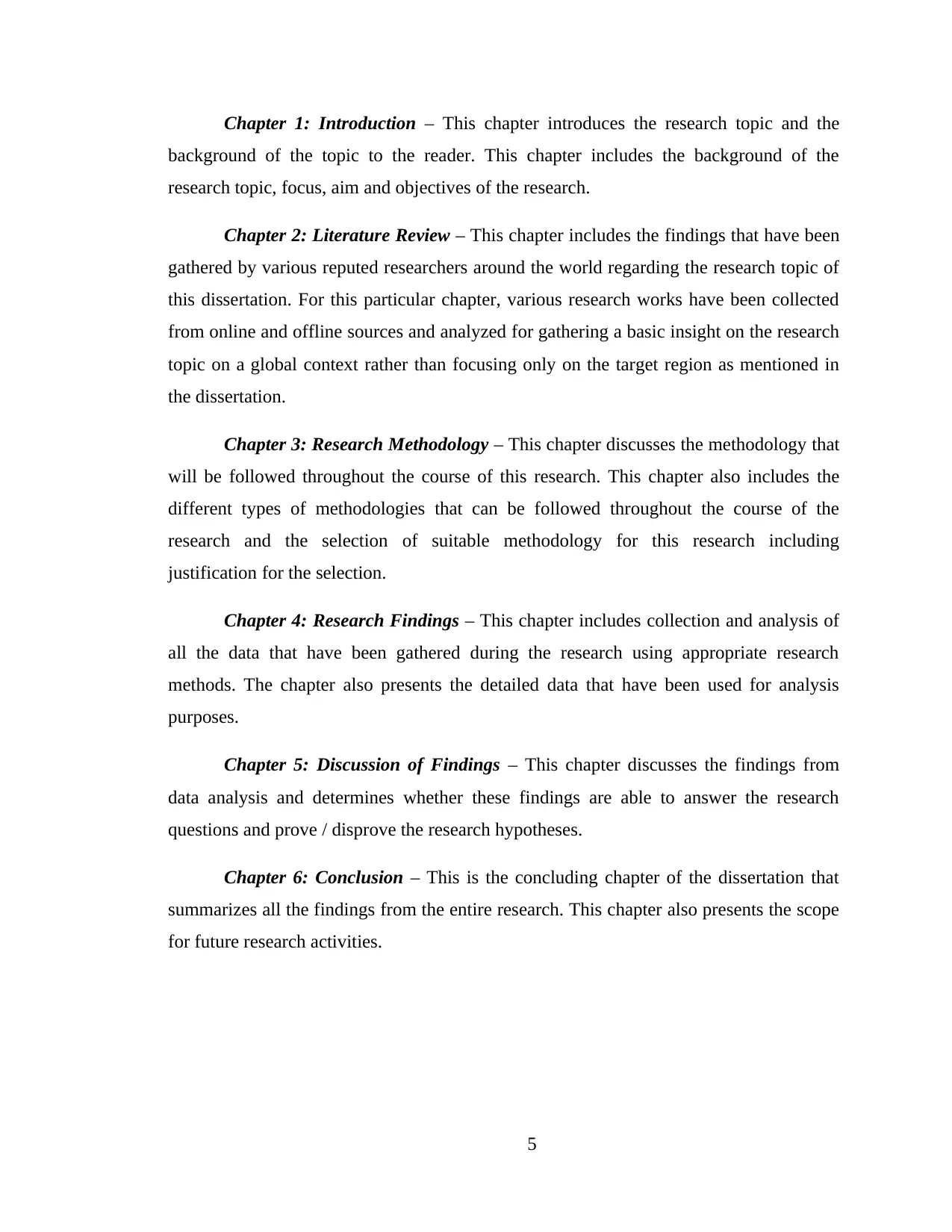
Chapter 1: Introduction – This chapter introduces the research topic and the
background of the topic to the reader. This chapter includes the background of the
research topic, focus, aim and objectives of the research.
Chapter 2: Literature Review – This chapter includes the findings that have been
gathered by various reputed researchers around the world regarding the research topic of
this dissertation. For this particular chapter, various research works have been collected
from online and offline sources and analyzed for gathering a basic insight on the research
topic on a global context rather than focusing only on the target region as mentioned in
the dissertation.
Chapter 3: Research Methodology – This chapter discusses the methodology that
will be followed throughout the course of this research. This chapter also includes the
different types of methodologies that can be followed throughout the course of the
research and the selection of suitable methodology for this research including
justification for the selection.
Chapter 4: Research Findings – This chapter includes collection and analysis of
all the data that have been gathered during the research using appropriate research
methods. The chapter also presents the detailed data that have been used for analysis
purposes.
Chapter 5: Discussion of Findings – This chapter discusses the findings from
data analysis and determines whether these findings are able to answer the research
questions and prove / disprove the research hypotheses.
Chapter 6: Conclusion – This is the concluding chapter of the dissertation that
summarizes all the findings from the entire research. This chapter also presents the scope
for future research activities.
5
background of the topic to the reader. This chapter includes the background of the
research topic, focus, aim and objectives of the research.
Chapter 2: Literature Review – This chapter includes the findings that have been
gathered by various reputed researchers around the world regarding the research topic of
this dissertation. For this particular chapter, various research works have been collected
from online and offline sources and analyzed for gathering a basic insight on the research
topic on a global context rather than focusing only on the target region as mentioned in
the dissertation.
Chapter 3: Research Methodology – This chapter discusses the methodology that
will be followed throughout the course of this research. This chapter also includes the
different types of methodologies that can be followed throughout the course of the
research and the selection of suitable methodology for this research including
justification for the selection.
Chapter 4: Research Findings – This chapter includes collection and analysis of
all the data that have been gathered during the research using appropriate research
methods. The chapter also presents the detailed data that have been used for analysis
purposes.
Chapter 5: Discussion of Findings – This chapter discusses the findings from
data analysis and determines whether these findings are able to answer the research
questions and prove / disprove the research hypotheses.
Chapter 6: Conclusion – This is the concluding chapter of the dissertation that
summarizes all the findings from the entire research. This chapter also presents the scope
for future research activities.
5
Paraphrase This Document
Need a fresh take? Get an instant paraphrase of this document with our AI Paraphraser
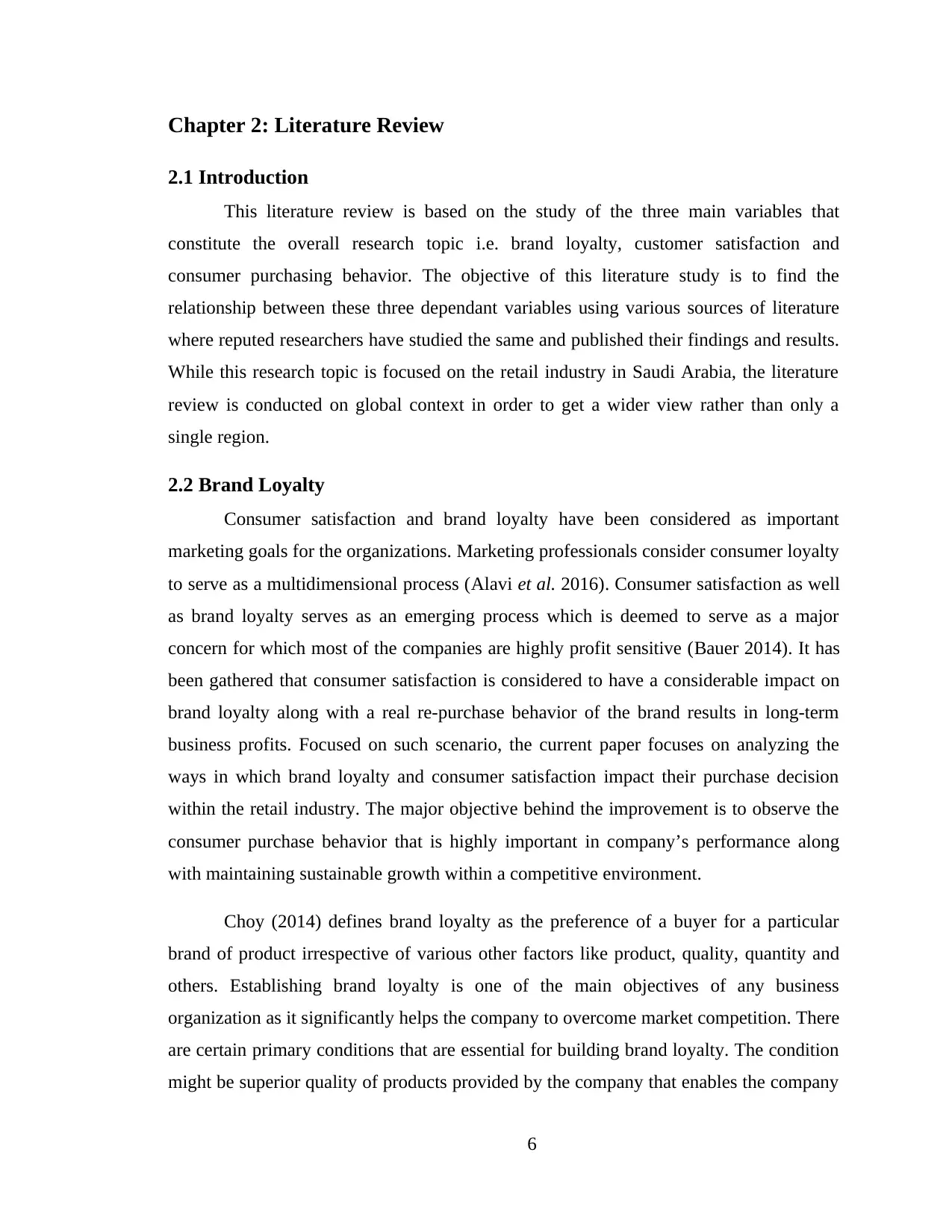
Chapter 2: Literature Review
2.1 Introduction
This literature review is based on the study of the three main variables that
constitute the overall research topic i.e. brand loyalty, customer satisfaction and
consumer purchasing behavior. The objective of this literature study is to find the
relationship between these three dependant variables using various sources of literature
where reputed researchers have studied the same and published their findings and results.
While this research topic is focused on the retail industry in Saudi Arabia, the literature
review is conducted on global context in order to get a wider view rather than only a
single region.
2.2 Brand Loyalty
Consumer satisfaction and brand loyalty have been considered as important
marketing goals for the organizations. Marketing professionals consider consumer loyalty
to serve as a multidimensional process (Alavi et al. 2016). Consumer satisfaction as well
as brand loyalty serves as an emerging process which is deemed to serve as a major
concern for which most of the companies are highly profit sensitive (Bauer 2014). It has
been gathered that consumer satisfaction is considered to have a considerable impact on
brand loyalty along with a real re-purchase behavior of the brand results in long-term
business profits. Focused on such scenario, the current paper focuses on analyzing the
ways in which brand loyalty and consumer satisfaction impact their purchase decision
within the retail industry. The major objective behind the improvement is to observe the
consumer purchase behavior that is highly important in company’s performance along
with maintaining sustainable growth within a competitive environment.
Choy (2014) defines brand loyalty as the preference of a buyer for a particular
brand of product irrespective of various other factors like product, quality, quantity and
others. Establishing brand loyalty is one of the main objectives of any business
organization as it significantly helps the company to overcome market competition. There
are certain primary conditions that are essential for building brand loyalty. The condition
might be superior quality of products provided by the company that enables the company
6
2.1 Introduction
This literature review is based on the study of the three main variables that
constitute the overall research topic i.e. brand loyalty, customer satisfaction and
consumer purchasing behavior. The objective of this literature study is to find the
relationship between these three dependant variables using various sources of literature
where reputed researchers have studied the same and published their findings and results.
While this research topic is focused on the retail industry in Saudi Arabia, the literature
review is conducted on global context in order to get a wider view rather than only a
single region.
2.2 Brand Loyalty
Consumer satisfaction and brand loyalty have been considered as important
marketing goals for the organizations. Marketing professionals consider consumer loyalty
to serve as a multidimensional process (Alavi et al. 2016). Consumer satisfaction as well
as brand loyalty serves as an emerging process which is deemed to serve as a major
concern for which most of the companies are highly profit sensitive (Bauer 2014). It has
been gathered that consumer satisfaction is considered to have a considerable impact on
brand loyalty along with a real re-purchase behavior of the brand results in long-term
business profits. Focused on such scenario, the current paper focuses on analyzing the
ways in which brand loyalty and consumer satisfaction impact their purchase decision
within the retail industry. The major objective behind the improvement is to observe the
consumer purchase behavior that is highly important in company’s performance along
with maintaining sustainable growth within a competitive environment.
Choy (2014) defines brand loyalty as the preference of a buyer for a particular
brand of product irrespective of various other factors like product, quality, quantity and
others. Establishing brand loyalty is one of the main objectives of any business
organization as it significantly helps the company to overcome market competition. There
are certain primary conditions that are essential for building brand loyalty. The condition
might be superior quality of products provided by the company that enables the company
6
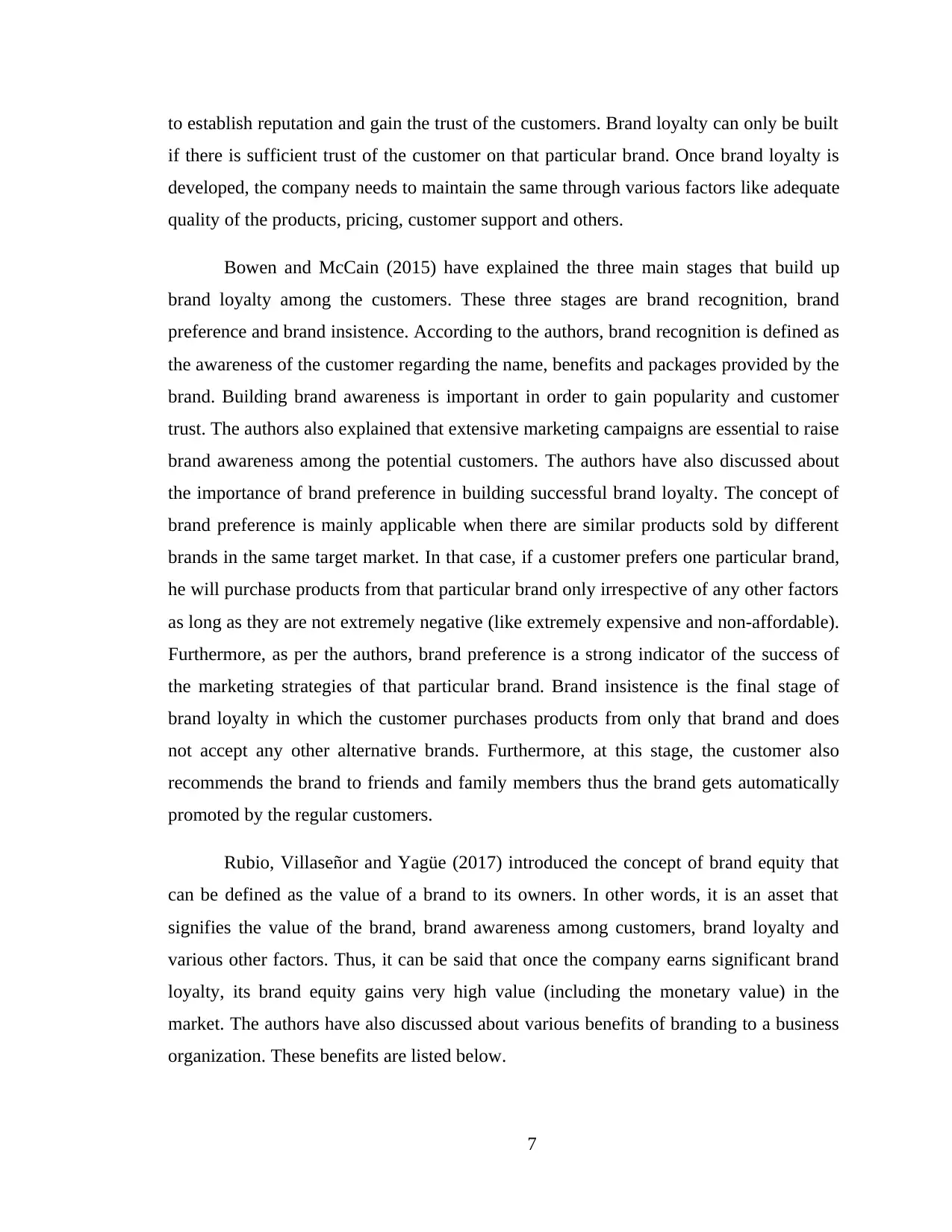
to establish reputation and gain the trust of the customers. Brand loyalty can only be built
if there is sufficient trust of the customer on that particular brand. Once brand loyalty is
developed, the company needs to maintain the same through various factors like adequate
quality of the products, pricing, customer support and others.
Bowen and McCain (2015) have explained the three main stages that build up
brand loyalty among the customers. These three stages are brand recognition, brand
preference and brand insistence. According to the authors, brand recognition is defined as
the awareness of the customer regarding the name, benefits and packages provided by the
brand. Building brand awareness is important in order to gain popularity and customer
trust. The authors also explained that extensive marketing campaigns are essential to raise
brand awareness among the potential customers. The authors have also discussed about
the importance of brand preference in building successful brand loyalty. The concept of
brand preference is mainly applicable when there are similar products sold by different
brands in the same target market. In that case, if a customer prefers one particular brand,
he will purchase products from that particular brand only irrespective of any other factors
as long as they are not extremely negative (like extremely expensive and non-affordable).
Furthermore, as per the authors, brand preference is a strong indicator of the success of
the marketing strategies of that particular brand. Brand insistence is the final stage of
brand loyalty in which the customer purchases products from only that brand and does
not accept any other alternative brands. Furthermore, at this stage, the customer also
recommends the brand to friends and family members thus the brand gets automatically
promoted by the regular customers.
Rubio, Villaseñor and Yagüe (2017) introduced the concept of brand equity that
can be defined as the value of a brand to its owners. In other words, it is an asset that
signifies the value of the brand, brand awareness among customers, brand loyalty and
various other factors. Thus, it can be said that once the company earns significant brand
loyalty, its brand equity gains very high value (including the monetary value) in the
market. The authors have also discussed about various benefits of branding to a business
organization. These benefits are listed below.
7
if there is sufficient trust of the customer on that particular brand. Once brand loyalty is
developed, the company needs to maintain the same through various factors like adequate
quality of the products, pricing, customer support and others.
Bowen and McCain (2015) have explained the three main stages that build up
brand loyalty among the customers. These three stages are brand recognition, brand
preference and brand insistence. According to the authors, brand recognition is defined as
the awareness of the customer regarding the name, benefits and packages provided by the
brand. Building brand awareness is important in order to gain popularity and customer
trust. The authors also explained that extensive marketing campaigns are essential to raise
brand awareness among the potential customers. The authors have also discussed about
the importance of brand preference in building successful brand loyalty. The concept of
brand preference is mainly applicable when there are similar products sold by different
brands in the same target market. In that case, if a customer prefers one particular brand,
he will purchase products from that particular brand only irrespective of any other factors
as long as they are not extremely negative (like extremely expensive and non-affordable).
Furthermore, as per the authors, brand preference is a strong indicator of the success of
the marketing strategies of that particular brand. Brand insistence is the final stage of
brand loyalty in which the customer purchases products from only that brand and does
not accept any other alternative brands. Furthermore, at this stage, the customer also
recommends the brand to friends and family members thus the brand gets automatically
promoted by the regular customers.
Rubio, Villaseñor and Yagüe (2017) introduced the concept of brand equity that
can be defined as the value of a brand to its owners. In other words, it is an asset that
signifies the value of the brand, brand awareness among customers, brand loyalty and
various other factors. Thus, it can be said that once the company earns significant brand
loyalty, its brand equity gains very high value (including the monetary value) in the
market. The authors have also discussed about various benefits of branding to a business
organization. These benefits are listed below.
7
⊘ This is a preview!⊘
Do you want full access?
Subscribe today to unlock all pages.

Trusted by 1+ million students worldwide
1 out of 77
Related Documents
Your All-in-One AI-Powered Toolkit for Academic Success.
+13062052269
info@desklib.com
Available 24*7 on WhatsApp / Email
![[object Object]](/_next/static/media/star-bottom.7253800d.svg)
Unlock your academic potential
Copyright © 2020–2025 A2Z Services. All Rights Reserved. Developed and managed by ZUCOL.





